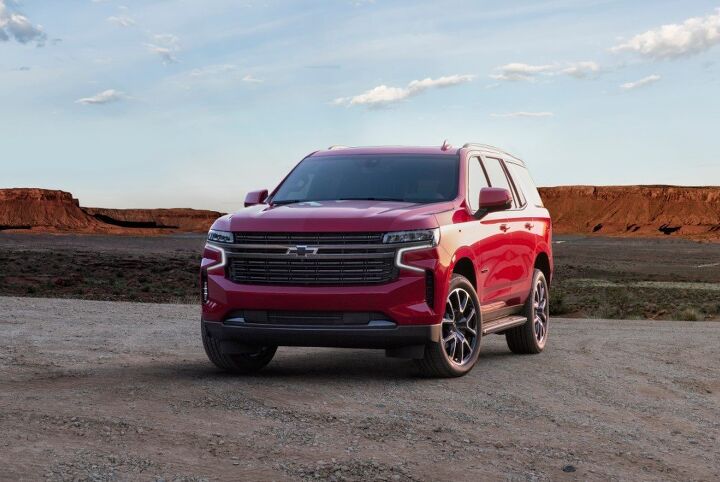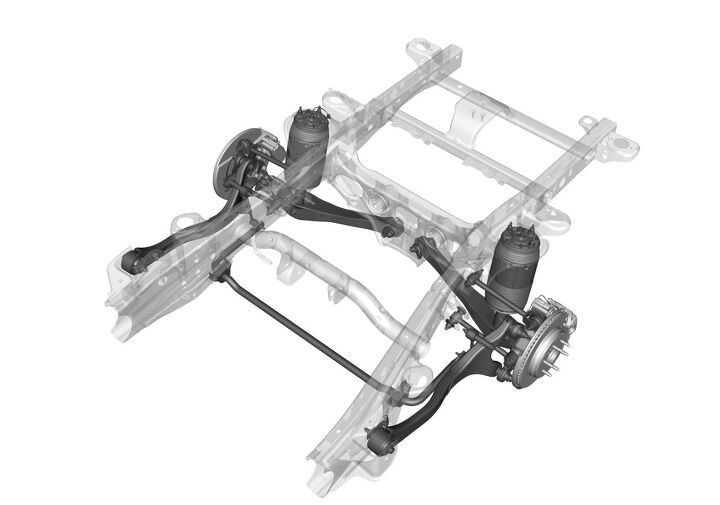2021 Chevrolet Suburban and Tahoe: America, Your Ride Awaits

Eighty-five years after its debut, the Chevrolet Suburban is still looking to conquer new lands. This time around, that seized territory lies between the front and rear bumper of the vehicle, and that goes double for its shorter body-on-frame sibling, the Tahoe.
Introduced Tuesday night in the birthplace of it all, Detroit, the 2021 Tahoe and Suburban mark the greatest leap forward in the models’ lineage to date. There’s acres more room, but the big-ticket items lie under the hood and within the rear wheel wells.
Yes, General Motors’ full-size SUVs break with tradition and move to an independent rear suspension for 2021. Gone is the solid truck axle; in its place, a multilink setup that can be optioned with Magnetic Ride Control or a class-exclusive, height-adjustable air suspension that affords drivers four inches of up-and-down adjustment.
Greeting buyers with an arguably terrifying face lifted, in part, from the questionably revamped Silverado 1500, the Tahoe and Suburban retain their boxy exterior proportions, as it turns out boxes are quite spacious inside. These ones are, too — considerably more so than the outgoing generation.
Dimension-wise, the re-platformed Tahoe sees the biggest gain in territory. Wheelbase grows 4.9 inches and overall length expands 6.7 inches, with the newfound stretch benefitting rear-seat passengers the most. Second-row passengers gain three inches of legroom; third-row passengers can now be adults thanks to a 10.1-inch boost in lower extremity acreage. Behind that seat, cargo volume expands to 25.5 cubic feet — a gain of 10.2 cubes.
Ray Ban-clad security details will appreciate the additional room.
With less room to expand outward, the Suburban’s dimensions see less change, but it’s not insignificant. While overall length grows just 1.3 inches, wheelbase it up 4.1 inches. Legroom for second- and third-row passengers increases 2.3 and 2.2 inches, respectively, and rear cargo volume rises 1.8 cubic feet to a grand total of 41.1 cubes. Aiding those long-ignored third-row passengers are second-row seats that offer 10 inches of back-and-forth travel.
With seats folded down, available cargo room in the Tahoe and Suburban grows 28.2 and 23 cubic feet apiece.
That’s the size news; up front, two big changes are afoot. For one, all powerplants will pair with a 10-speed automatic (previous Tahoes and Suburbans only paired that unit with the uplevel 6.2-liter; now, it’s available on the base 5.3-liter). Power for both Dynamic Fuel Management-equipped engines remains the same, though buyers will now be able to option their SUV with GM’s 3.0-liter inline-six diesel.
In the Silverado, GM’s new oil-burner returns 33 mpg highway and 27 mpg combined in rear-drive guise, so figure something close to that when the EPA gets around to testing these things.
Elsewhere on the pair, standard LED lamps appear fore and aft, no doubt helping the models’ future standing with the IIHS. Flanking the no-doubt-polarizing grille appears to be air curtain front fenders that should reduce buffeting (and drag) around the front wheel wells. Grille shutters further aid this lengthy box’s aerodynamics.
Trim-wise, the Suburban and Tahoe double up on choice. For 2021, the range starts at LS and moves up through LT, Z71 (a bonafide trim now), RST, Premier, and top-flight High Country. As with the 1500 and Heavy Duty Silverados, High Country offers the most appealing iteration of Chevy’s now-corporate grille. The 6.2-liter is standard on all but the topmost trim; interestingly, the 3.0L Duramax is optional on all but the Z71. (Nary of a mention of that four-cylinder GM won’t call a four-cylinder, but the dropping of the unpopular four-banger variant of the Traverse foreshadowed the 2.7-liter’s exclusion from these models’ powerplant list.)
As for those trick suspensions, the road surface-monitoring Magnetic Ride Control is standard kit on Premier and High Country, available on Z71. Those latter two trim are also available with the Air Ride Adaptive Suspension GM would love buyers to shell out for. Wheel sizes starts at 18 inches for LS and LT, moving through 20-inches for the RST and Z71, up to 22-inch hoops for the RST and High Country. Trim-specific grille treatments will help differentiate the models when spotted out in the wild.
Inside, all Tahoe and Suburban buyers are greeted with a 10-inch infotainment screen, with a 4.2-inch driver information center appearing in the gauge cluster for LS, LT, RST, and Z71 customers. Premier and High Country buyers see an 8-inch info display. The uppermost trim also gets a 15-inch (diagonal) head-up display that’s available on the Premier.
As for backseat passengers, they won’t have to use their imagination to pass the time, so long as the buyer opted for dual 12.6-inch LCD touchscreens — each one programmable by passengers on that side of the vehicle, regardless of seat. A Wi-Fi hotspot and standard Apple CarPlay and Android Auto connectivity should lessen the boredom, regardless of where you’re sitting.
As for price, that’ll have to wait until closer to the Tahoe and Suburban’s summer 2020 release date.
[Images: General Motors]

More by Steph Willems
Latest Car Reviews
Read moreLatest Product Reviews
Read moreRecent Comments
- ToolGuy If these guys opened a hotel outside Cincinnati I would go there to sleep, and to dream.
- ToolGuy Michelin's price increases mean that my relationship with them as a customer is not sustainable. 🙁
- Kwik_Shift_Pro4X I wonder if Fiat would pull off old world Italian charm full of well intentioned stereotypes.
- Chelsea I actually used to work for this guy
- SaulTigh Saw my first Cybertruck last weekend. Looked like a kit car...not an even panel to be seen.








































Comments
Join the conversation
I love it. Any other car..lets just, for familiarity sakes, say it's LEXUS..if it were Lexus man would these new GM trucks be hammered for those ugly AF grills. Good job aping Ford styling and rear suspension though GM. And are the back ends of these things pre-broken? They sure look like they've been cracked almost in half in every picture I've seen so far. GM does it again!
Looks like quite an interesting design for a 4 link independent rear axle. I guess a unitized body was a step too far, but the suspension is as dependent on squishy bushings for actual hub articulation movement as a Mercedes. But at least the laughable stick rear axle has been jettisoned. If you still want to buck and heave and tow horse trailers there's always pickups. I see on another site that BWI is making the air springs. They already make the magnetic ride dampers for all GM, and VW. If you want to be riled up about Chinesium, BWI is BeijingWest Industries, the folks who took Delphi Magneride off GM's hands back in 2009. They have just opened a facility in Greenfield IN, so maybe the dampers and airsprings for these new SUVs will be US-sourced. Besides China, their other three factories up to now are in Eastern Europe and the UK.